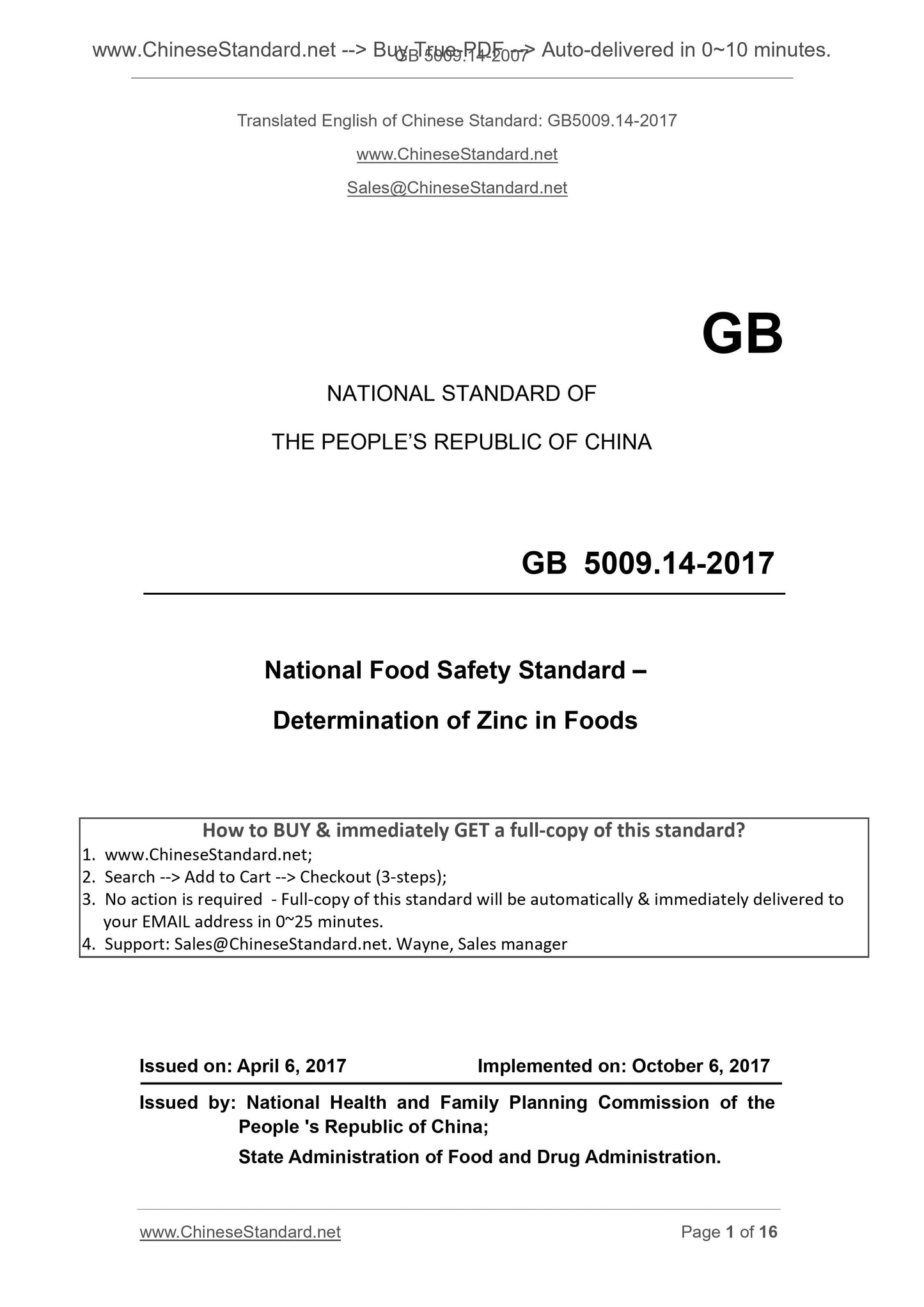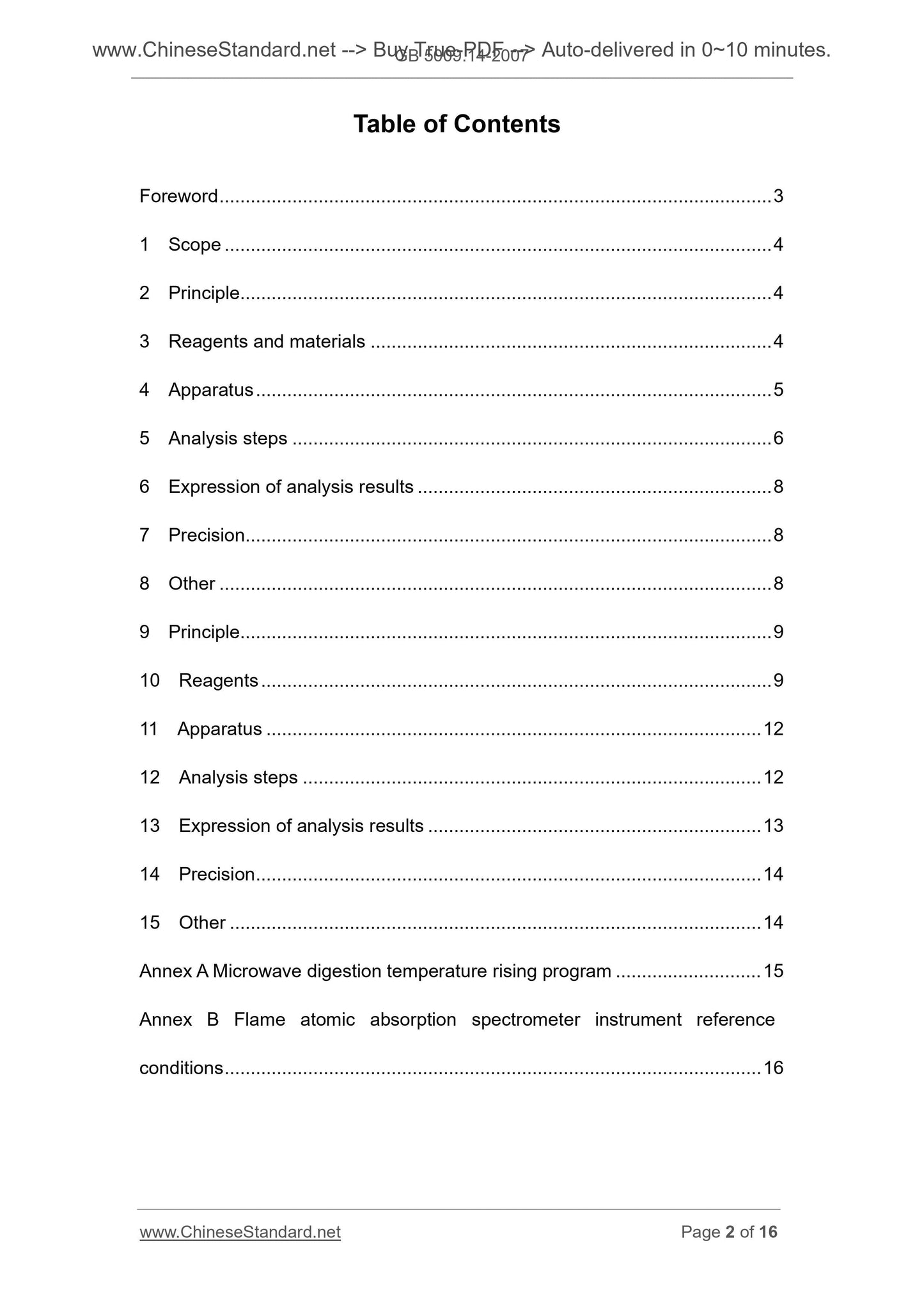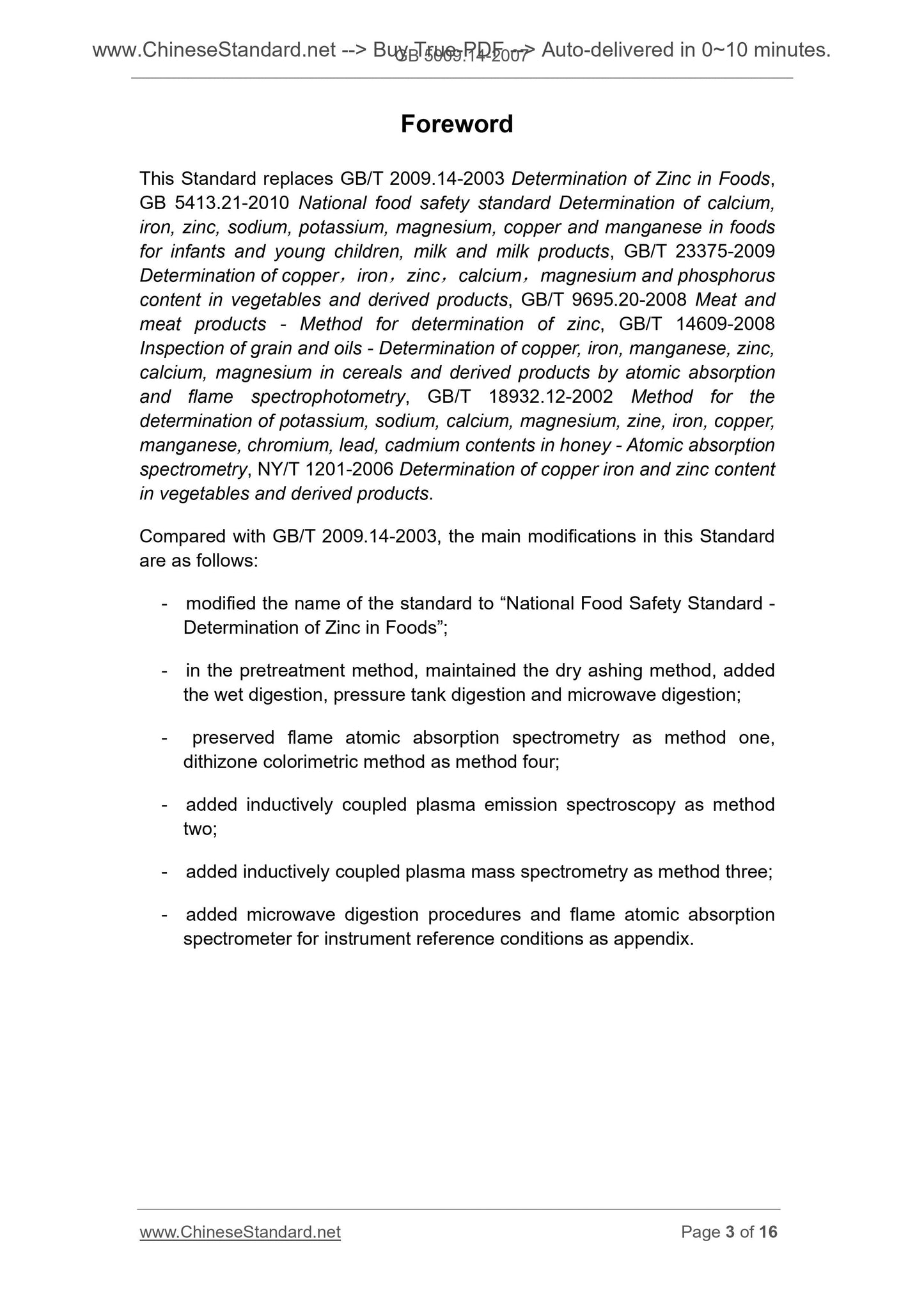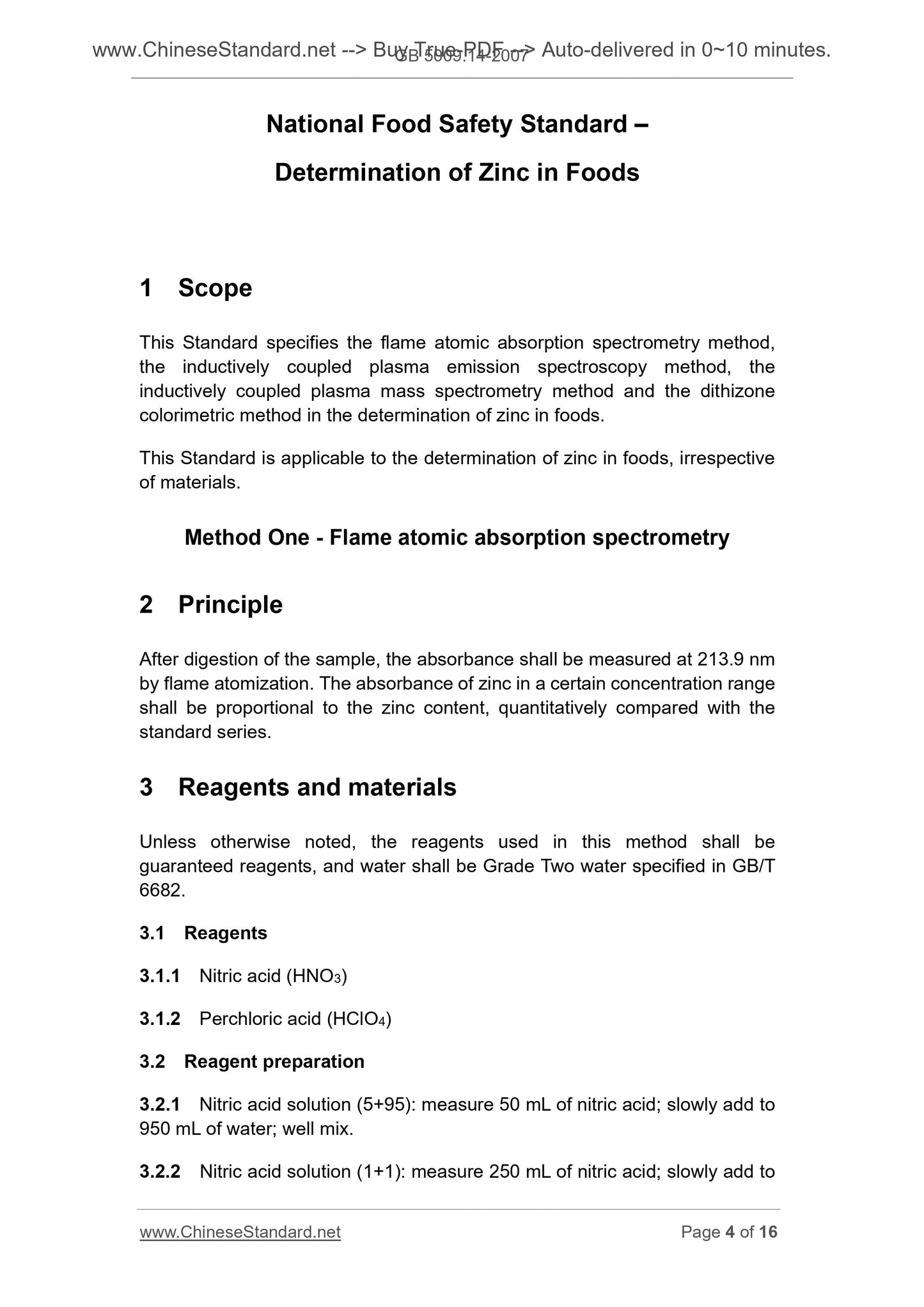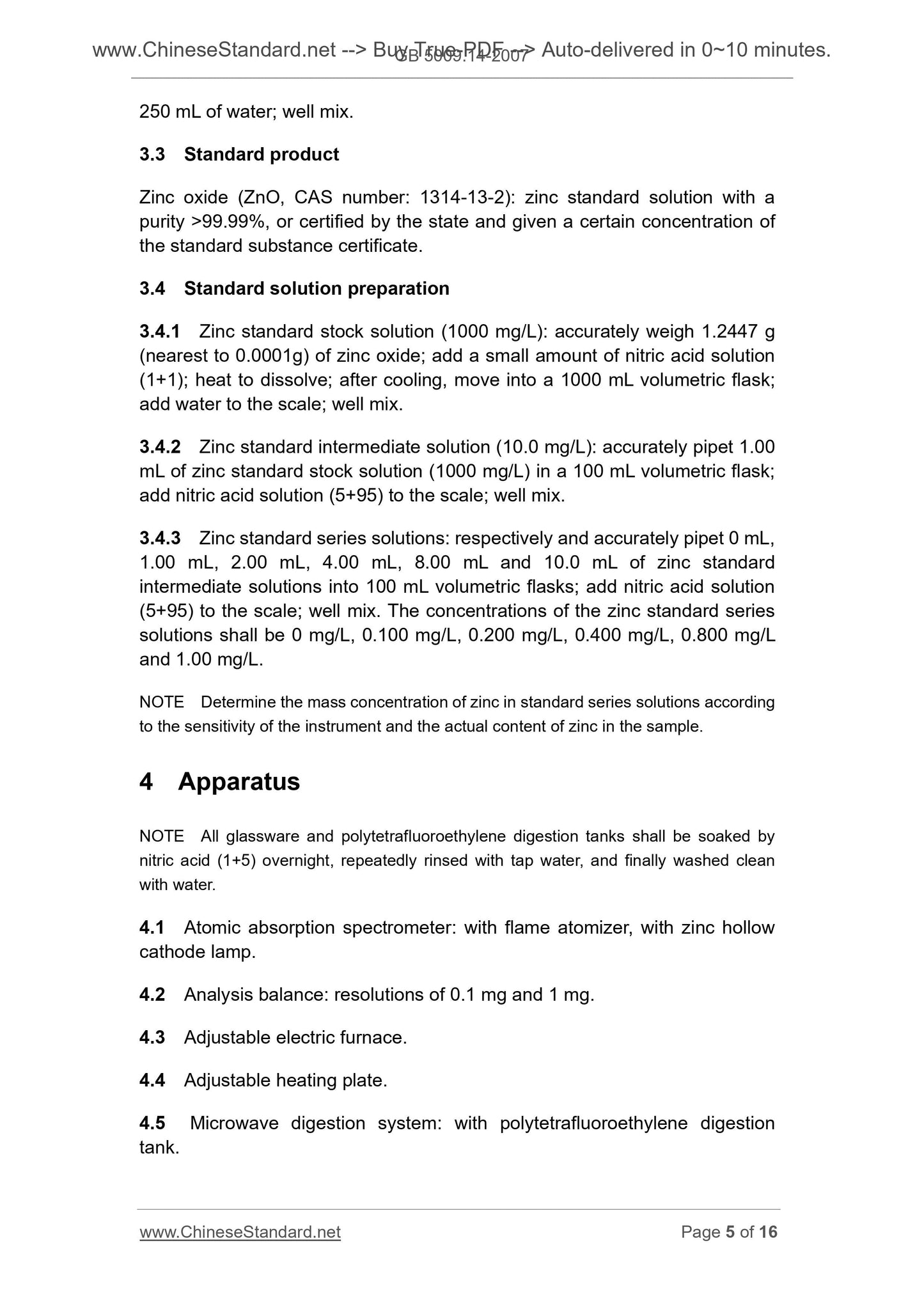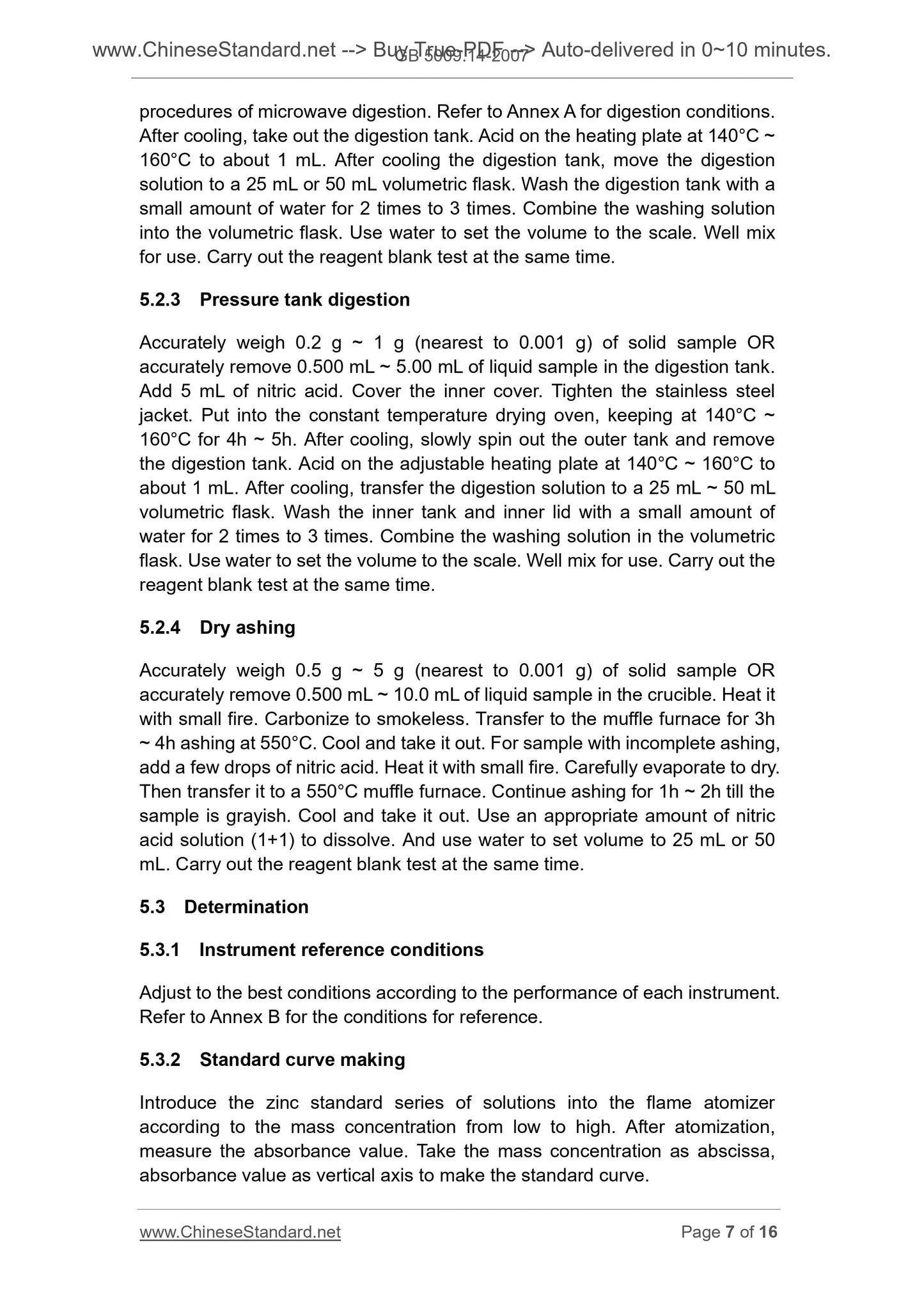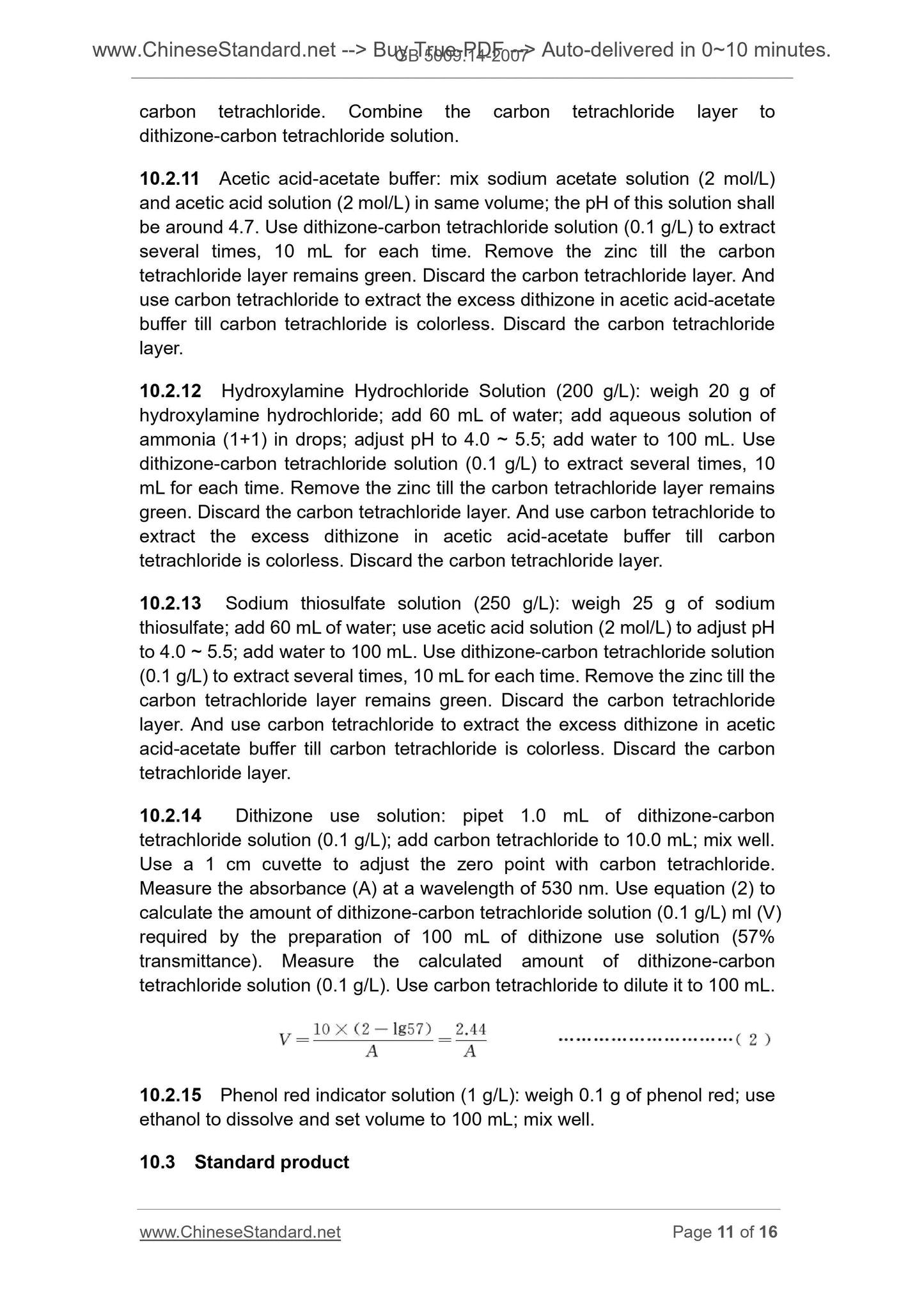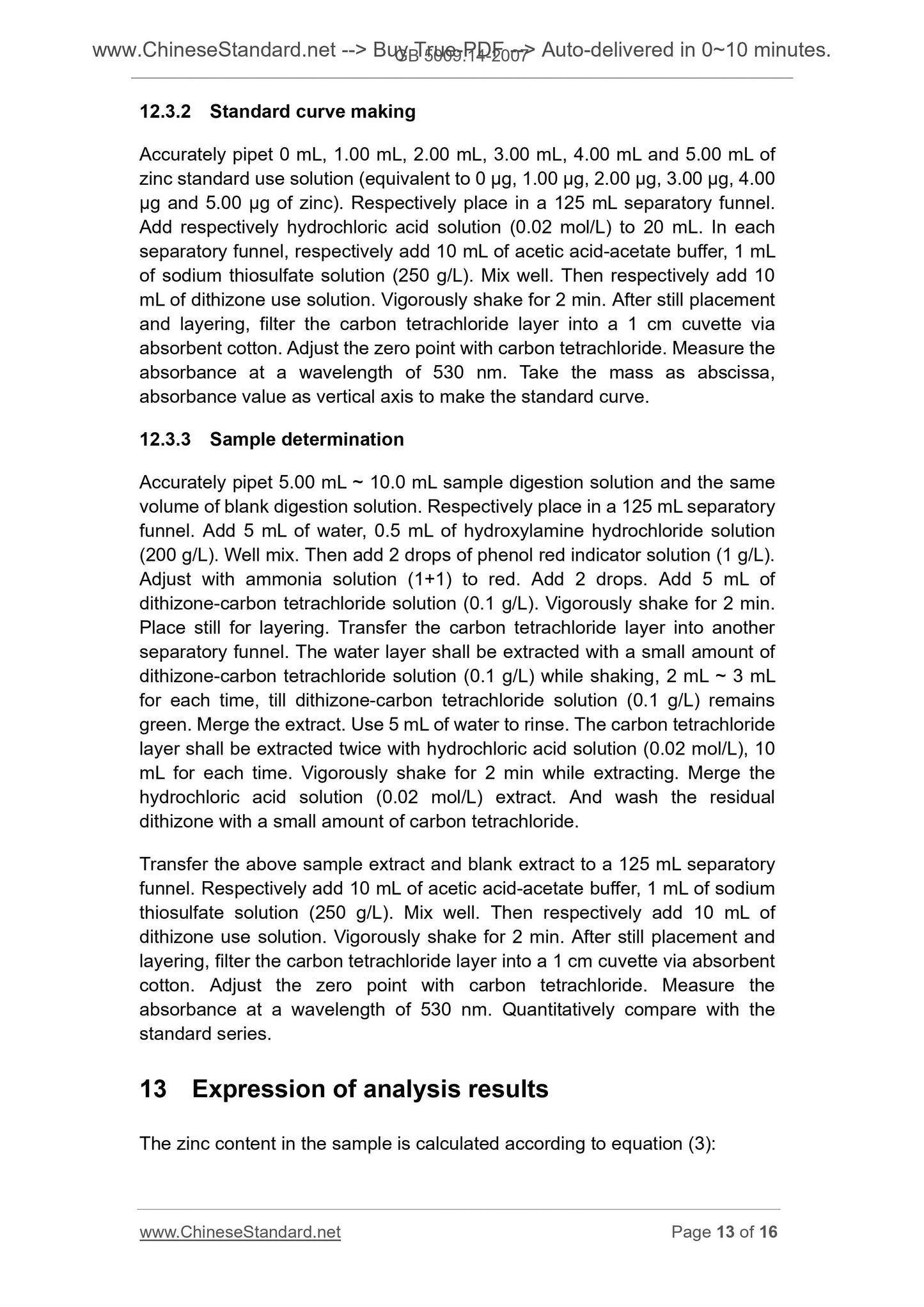1
/
of
8
PayPal, credit cards. Download editable-PDF & invoice in 1 second!
GB 5009.14-2017 English PDF
GB 5009.14-2017 English PDF
Regular price
$85.00 USD
Regular price
Sale price
$85.00 USD
Unit price
/
per
Shipping calculated at checkout.
Couldn't load pickup availability
Delivery: 3 seconds. Download true-PDF + Invoice.
Get QUOTATION in 1-minute: Click GB 5009.14-2017
Historical versions: GB 5009.14-2017
Preview True-PDF (Reload/Scroll if blank)
GB 5009.14-2017: Food safety national standard -- Determination of Zinc in Food
GB 5009.14-2007
GB
NATIONAL STANDARD OF
THE PEOPLE’S REPUBLIC OF CHINA
National Food Safety Standard –
Determination of Zinc in Foods
ISSUED ON. APRIL 6, 2017
IMPLEMENTED ON. OCTOBER 6, 2017
Issued by. National Health and Family Planning Commission of the
People 's Republic of China;
State Administration of Food and Drug Administration.
Table of Contents
Foreword ... 3
1 Scope ... 4
2 Principle... 4
3 Reagents and materials ... 4
4 Apparatus ... 5
5 Analysis steps ... 6
6 Expression of analysis results ... 8
7 Precision... 8
8 Other ... 8
9 Principle... 9
10 Reagents ... 9
11 Apparatus ... 12
12 Analysis steps ... 12
13 Expression of analysis results ... 13
14 Precision ... 14
15 Other ... 14
Annex A Microwave digestion temperature rising program ... 15
Annex B Flame atomic absorption spectrometer instrument reference
conditions ... 16
Foreword
This Standard replaces GB/T 2009.14-2003 Determination of Zinc in Foods,
GB 5413.21-2010 National food safety standard Determination of calcium,
iron, zinc, sodium, potassium, magnesium, copper and manganese in foods
for infants and young children, milk and milk products, GB/T 23375-2009
Determination of copper, iron, zinc, calcium, magnesium and phosphorus
content in vegetables and derived products, GB/T 9695.20-2008 Meat and
meat products - Method for determination of zinc, GB/T 14609-2008
Inspection of grain and oils - Determination of copper, iron, manganese, zinc,
calcium, magnesium in cereals and derived products by atomic absorption
and flame spectrophotometry, GB/T 18932.12-2002 Method for the
determination of potassium, sodium, calcium, magnesium, zine, iron, copper,
manganese, chromium, lead, cadmium contents in honey - Atomic absorption
spectrometry, NY/T 1201-2006 Determination of copper iron and zinc content
in vegetables and derived products.
Compared with GB/T 2009.14-2003, the main modifications in this Standard
are as follows.
- modified the name of the standard to “National Food Safety Standard -
Determination of Zinc in Foods”;
- in the pretreatment method, maintained the dry ashing method, added
the wet digestion, pressure tank digestion and microwave digestion;
- preserved flame atomic absorption spectrometry as method one,
dithizone colorimetric method as method four;
- added inductively coupled plasma emission spectroscopy as method
two;
- added inductively coupled plasma mass spectrometry as method three;
- added microwave digestion procedures and flame atomic absorption
spectrometer for instrument reference conditions as appendix.
National Food Safety Standard –
Determination of Zinc in Foods
1 Scope
This Standard specifies the flame atomic absorption spectrometry method,
the inductively coupled plasma emission spectroscopy method, the
inductively coupled plasma mass spectrometry method and the dithizone
colorimetric method in the determination of zinc in foods.
This Standard is applicable to the determination of zinc in foods, irrespective
of materials.
Method One - Flame atomic absorption spectrometry
2 Principle
After digestion of the sample, the absorbance shall be measured at 213.9 nm
by flame atomization. The absorbance of zinc in a certain concentration range
shall be proportional to the zinc content, quantitatively compared with the
standard series.
3 Reagents and materials
Unless otherwise noted, the reagents used in this method shall be
guaranteed reagents, and water shall be Grade Two water specified in GB/T
6682.
3.1 Reagents
3.1.1 Nitric acid (HNO3)
3.1.2 Perchloric acid (HClO4)
3.2 Reagent preparation
3.2.1 Nitric acid solution (5+95). measure 50 mL of nitric acid; slowly add to
950 mL of water; well mix.
3.2.2 Nitric acid solution (1+1). measure 250 mL of nitric acid; slowly add to
250 mL of water; well mix.
3.3 Standard product
Zinc oxide (ZnO, CAS number. 1314-13-2). zinc standard solution with a
purity >99.99%, or certified by the state and given a certain concentration of
the standard substance certificate.
3.4 Standard solution preparation
3.4.1 Zinc standard stock solution (1000 mg/L). accurately weigh 1.2447 g
(nearest to 0.0001g) of zinc oxide; add a small amount of nitric acid solution
(1+1); heat to dissolve; after cooling, move into a 1000 mL volumetric flask;
add water to the scale; well mix.
3.4.2 Zinc standard intermediate solution (10.0 mg/L). accurately pipet 1.00
mL of zinc standard stock solution (1000 mg/L) in a 100 mL volumetric flask;
add nitric acid solution (5+95) to the scale; well mix.
3.4.3 Zinc standard series solutions. respectively and accurately pipet 0 mL,
1.00 mL, 2.00 mL, 4.00 mL, 8.00 mL and 10.0 mL of zinc standard
intermediate solutions into 100 mL volumetric flasks; add nitric acid solution
(5+95) to the scale; well mix. The concentrations of the zinc standard series
solutions shall be 0 mg/L, 0.100 mg/L, 0.200 mg/L, 0.400 mg/L, 0.800 mg/L
and 1.00 mg/L.
NOTE Determine the mass concentration of zinc in standard series solutions according
to the sensitivity of the instrument and the actual content of zinc in the sample.
4 Apparatus
NOTE All glassware and polytetrafluoroethylene digestion tanks shall be soaked by
nitric acid (1+5) overnight, repeatedly rinsed with tap water, and finally washed clean
with water.
4.1 Atomic absorption spectrometer. with flame atomizer, with zinc hollow
cathode lamp.
4.2 Analysis balance. resolutions of 0.1 mg and 1 mg.
4.3 Adjustable electric furnace.
4.4 Adjustable heating plate.
4.5 Microwave digestion system. with polytetrafluoroethylene digestion
tank.
procedures of microwave digestion. Refer to Annex A for digestion conditions.
After cooling, take out the digestion tank. Acid on the heating plate at 140°C ~
160°C to about 1 mL. After cooling the digestion tank, move the digestion
solution to a 25 mL or 50 mL volumetric flask. Wash the digestion tank with a
small amount of water for 2 times to 3 times. Combine the washing solution
into the volumetric flask. Use water to set the volume to the scale. Well mix
for use. Carry out the reagent blank test at the same time.
5.2.3 Pressure tank digestion
Accurately weigh 0.2 g ~ 1 g (nearest to 0.001 g) of solid sample OR
accurately remove 0.500 mL ~ 5.00 mL of liquid sample in the digestion tank.
Add 5 mL of nitric acid. Cover the inner cover. Tighten the stainless steel
jacket. Put into the constant temperature drying oven, keeping at 140°C ~
160°C for 4h ~ 5h. After cooling, slowly spin out the outer tank and remove
the digestion tank. Acid on the adjustable heating plate at 140°C ~ 160°C to
about 1 mL. After cooling, transfer the digestion solution to a 25 mL ~ 50 mL
volumetric flask. Wash the inner tank and inner lid with a small amount of
water for 2 times to 3 times. Combine the washing solution in the volumetric
flask. Use water to set the volume to the scale. Well mix for use. Carry out the
reagent blank test at the same time.
5.2.4 Dry ashing
Accurately weigh 0.5 g ~ 5 g (nearest to 0.001 g) of solid sample OR
accurately remove 0.500 mL ~ 10.0 mL of liquid sample in the crucible. Heat it
with small fire. Carbonize to smokeless. Transfer to the muffle furnace for 3h
~ 4h ashing at 550°C. Cool and take it out. For sample with incomplete ashing,
add a few drops of nitric acid. Heat it with small fire. Carefully evaporate to dry.
Then tra...
Get QUOTATION in 1-minute: Click GB 5009.14-2017
Historical versions: GB 5009.14-2017
Preview True-PDF (Reload/Scroll if blank)
GB 5009.14-2017: Food safety national standard -- Determination of Zinc in Food
GB 5009.14-2007
GB
NATIONAL STANDARD OF
THE PEOPLE’S REPUBLIC OF CHINA
National Food Safety Standard –
Determination of Zinc in Foods
ISSUED ON. APRIL 6, 2017
IMPLEMENTED ON. OCTOBER 6, 2017
Issued by. National Health and Family Planning Commission of the
People 's Republic of China;
State Administration of Food and Drug Administration.
Table of Contents
Foreword ... 3
1 Scope ... 4
2 Principle... 4
3 Reagents and materials ... 4
4 Apparatus ... 5
5 Analysis steps ... 6
6 Expression of analysis results ... 8
7 Precision... 8
8 Other ... 8
9 Principle... 9
10 Reagents ... 9
11 Apparatus ... 12
12 Analysis steps ... 12
13 Expression of analysis results ... 13
14 Precision ... 14
15 Other ... 14
Annex A Microwave digestion temperature rising program ... 15
Annex B Flame atomic absorption spectrometer instrument reference
conditions ... 16
Foreword
This Standard replaces GB/T 2009.14-2003 Determination of Zinc in Foods,
GB 5413.21-2010 National food safety standard Determination of calcium,
iron, zinc, sodium, potassium, magnesium, copper and manganese in foods
for infants and young children, milk and milk products, GB/T 23375-2009
Determination of copper, iron, zinc, calcium, magnesium and phosphorus
content in vegetables and derived products, GB/T 9695.20-2008 Meat and
meat products - Method for determination of zinc, GB/T 14609-2008
Inspection of grain and oils - Determination of copper, iron, manganese, zinc,
calcium, magnesium in cereals and derived products by atomic absorption
and flame spectrophotometry, GB/T 18932.12-2002 Method for the
determination of potassium, sodium, calcium, magnesium, zine, iron, copper,
manganese, chromium, lead, cadmium contents in honey - Atomic absorption
spectrometry, NY/T 1201-2006 Determination of copper iron and zinc content
in vegetables and derived products.
Compared with GB/T 2009.14-2003, the main modifications in this Standard
are as follows.
- modified the name of the standard to “National Food Safety Standard -
Determination of Zinc in Foods”;
- in the pretreatment method, maintained the dry ashing method, added
the wet digestion, pressure tank digestion and microwave digestion;
- preserved flame atomic absorption spectrometry as method one,
dithizone colorimetric method as method four;
- added inductively coupled plasma emission spectroscopy as method
two;
- added inductively coupled plasma mass spectrometry as method three;
- added microwave digestion procedures and flame atomic absorption
spectrometer for instrument reference conditions as appendix.
National Food Safety Standard –
Determination of Zinc in Foods
1 Scope
This Standard specifies the flame atomic absorption spectrometry method,
the inductively coupled plasma emission spectroscopy method, the
inductively coupled plasma mass spectrometry method and the dithizone
colorimetric method in the determination of zinc in foods.
This Standard is applicable to the determination of zinc in foods, irrespective
of materials.
Method One - Flame atomic absorption spectrometry
2 Principle
After digestion of the sample, the absorbance shall be measured at 213.9 nm
by flame atomization. The absorbance of zinc in a certain concentration range
shall be proportional to the zinc content, quantitatively compared with the
standard series.
3 Reagents and materials
Unless otherwise noted, the reagents used in this method shall be
guaranteed reagents, and water shall be Grade Two water specified in GB/T
6682.
3.1 Reagents
3.1.1 Nitric acid (HNO3)
3.1.2 Perchloric acid (HClO4)
3.2 Reagent preparation
3.2.1 Nitric acid solution (5+95). measure 50 mL of nitric acid; slowly add to
950 mL of water; well mix.
3.2.2 Nitric acid solution (1+1). measure 250 mL of nitric acid; slowly add to
250 mL of water; well mix.
3.3 Standard product
Zinc oxide (ZnO, CAS number. 1314-13-2). zinc standard solution with a
purity >99.99%, or certified by the state and given a certain concentration of
the standard substance certificate.
3.4 Standard solution preparation
3.4.1 Zinc standard stock solution (1000 mg/L). accurately weigh 1.2447 g
(nearest to 0.0001g) of zinc oxide; add a small amount of nitric acid solution
(1+1); heat to dissolve; after cooling, move into a 1000 mL volumetric flask;
add water to the scale; well mix.
3.4.2 Zinc standard intermediate solution (10.0 mg/L). accurately pipet 1.00
mL of zinc standard stock solution (1000 mg/L) in a 100 mL volumetric flask;
add nitric acid solution (5+95) to the scale; well mix.
3.4.3 Zinc standard series solutions. respectively and accurately pipet 0 mL,
1.00 mL, 2.00 mL, 4.00 mL, 8.00 mL and 10.0 mL of zinc standard
intermediate solutions into 100 mL volumetric flasks; add nitric acid solution
(5+95) to the scale; well mix. The concentrations of the zinc standard series
solutions shall be 0 mg/L, 0.100 mg/L, 0.200 mg/L, 0.400 mg/L, 0.800 mg/L
and 1.00 mg/L.
NOTE Determine the mass concentration of zinc in standard series solutions according
to the sensitivity of the instrument and the actual content of zinc in the sample.
4 Apparatus
NOTE All glassware and polytetrafluoroethylene digestion tanks shall be soaked by
nitric acid (1+5) overnight, repeatedly rinsed with tap water, and finally washed clean
with water.
4.1 Atomic absorption spectrometer. with flame atomizer, with zinc hollow
cathode lamp.
4.2 Analysis balance. resolutions of 0.1 mg and 1 mg.
4.3 Adjustable electric furnace.
4.4 Adjustable heating plate.
4.5 Microwave digestion system. with polytetrafluoroethylene digestion
tank.
procedures of microwave digestion. Refer to Annex A for digestion conditions.
After cooling, take out the digestion tank. Acid on the heating plate at 140°C ~
160°C to about 1 mL. After cooling the digestion tank, move the digestion
solution to a 25 mL or 50 mL volumetric flask. Wash the digestion tank with a
small amount of water for 2 times to 3 times. Combine the washing solution
into the volumetric flask. Use water to set the volume to the scale. Well mix
for use. Carry out the reagent blank test at the same time.
5.2.3 Pressure tank digestion
Accurately weigh 0.2 g ~ 1 g (nearest to 0.001 g) of solid sample OR
accurately remove 0.500 mL ~ 5.00 mL of liquid sample in the digestion tank.
Add 5 mL of nitric acid. Cover the inner cover. Tighten the stainless steel
jacket. Put into the constant temperature drying oven, keeping at 140°C ~
160°C for 4h ~ 5h. After cooling, slowly spin out the outer tank and remove
the digestion tank. Acid on the adjustable heating plate at 140°C ~ 160°C to
about 1 mL. After cooling, transfer the digestion solution to a 25 mL ~ 50 mL
volumetric flask. Wash the inner tank and inner lid with a small amount of
water for 2 times to 3 times. Combine the washing solution in the volumetric
flask. Use water to set the volume to the scale. Well mix for use. Carry out the
reagent blank test at the same time.
5.2.4 Dry ashing
Accurately weigh 0.5 g ~ 5 g (nearest to 0.001 g) of solid sample OR
accurately remove 0.500 mL ~ 10.0 mL of liquid sample in the crucible. Heat it
with small fire. Carbonize to smokeless. Transfer to the muffle furnace for 3h
~ 4h ashing at 550°C. Cool and take it out. For sample with incomplete ashing,
add a few drops of nitric acid. Heat it with small fire. Carefully evaporate to dry.
Then tra...
Share
